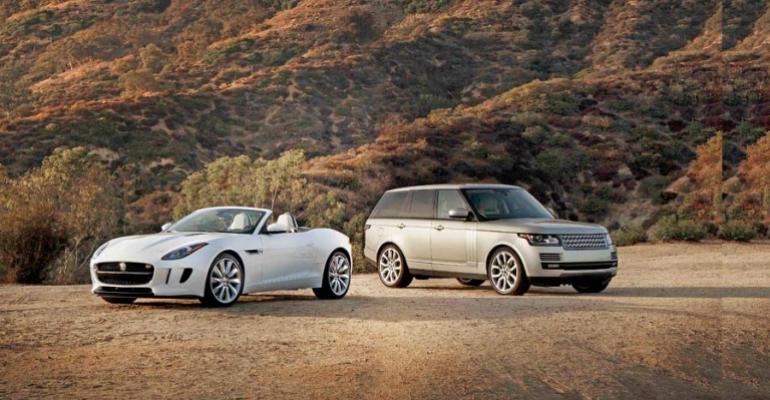LOS ANGELES – Jaguar and Land Rover are paired-up British aristocratic automotive brands owned by an Indian firm and overseen by a German CEO.
A push is on to sell more of the U.K.-made vehicles, particularly in cash-rich China as well as established U.S. luxury markets, such as this celebrity spot. So says Lindsay Duffield, who heads the JLR unit in Canada.
If the world is a stage, then the 2-brand auto maker is on it and determined to not play a bit part. A juicy co-starring role would do.
Referring to “the rebirth of two luxury automotive icons,” Duffield predicts worldwide sales of 373,636 vehicles this year, up 15,863 over last year. If things keep going well and “barring a global (economic) meltdown,” he forecasts annual deliveries of 800,000 by 2020.
The once-floundering auto maker is thinking big, but not in titanic terms.
“We don’t need to sell 2 million vehicles a year,” he says at the Automotive Customer Centricity Summit put on by Thought Leadership Summits here. “Maybe we can hit a million, being a niche brand profitable for ourselves and our dealers.”
The two nameplates offer markedly different vehicles, yet both are bluebloods rebounding from hard times in recent years.
With a rich racing heritage, Jaguar sells four car models blending speed and sculpted designs. The least-expensive XF sedan starts at $46,975. Assorted options push the top-of-the-line XK into six figures fast.
Land Rover’s all-SUV lineup consists of five vehicles, including the flagship Range Rover, which counts Queen Elizabeth II of England as an owner-driver. The brand’s entry-level LR2 starts at $37,295.
The brands aren’t interested in pricing much lower than that, even though some premium competitors are trying to widen customer bases by introducing under-$30,000 near-luxury models, such as the Mercedes-Benz CLA.
“We can be that more exclusive vehicle for the more discerning customer who doesn’t want to be seen in just another luxury car,” Duffield says, adding that the auto maker has made a point of showing Jaguars and Land Rovers “all over L.A.,” including showcase appearances in Beverly Hills and Hollywood.
“We’re also spending a lot of money on driving events,” Duffield says. “We know if we can get people behind the wheel, we’ll sell cars.”
In engineering and production, the auto maker is trying to distinguish itself by the liberal and increasing use of aluminum, particularly in bodies, he says. “We believe we are the most advanced (auto maker) when it comes to using aluminum.”
The ’14 Range Rover Sport shed 800 lbs. (363 kg) largely because of a new aluminum unibody, replacing a body-on-frame steel structure in the previous model.
Aluminum is lighter but more expensive than steel. JLR “is going strong in aluminum” as it seeks low-cost sources of the material, Duffield says.
Not long ago, the company appeared ready for almshouse residency. Tata, a conglomerate based in India, purchased the two brands for $2.3 billion from Ford in 2008. But the year ended dismally as the auto industry began feeling sharp pains from a worsening economy.
JLR global sales fell from 304,927 units in 2002 to 196,626 in 2009. “Things were not the greatest when Tata bought the company,” Duffield says. “We immediately went into a recession. People said, ‘Man, they paid too much; they’re not going to be around for long! We were flirting with bankruptcy five years ago.”
The auto maker maneuvered out of the minefields bloodied but not beaten.
“Now, there is great news coming out of the firm,” Duffield says, going down a list that includes 8,000 new hires in the past two years; plans for a $500 million engine plant; and a projected 26% increase in dealerships by 2017.
It took a major reorganization to rejuvenate the brands and remains a work in progress. “It feels a lot like a startup,” Duffield says. “It’s like building a dam as the river runs through it.”
Despite their different DNAs, the two brands play well off each other, especially at dualed dealerships where “the cars are on one side of the store, and SUVs are on the other” and the back end is shared by both, he says.
Keeping Jaguar and Land Rover as separate brand entities is “sacrosanct,” Duffield tells WardsAuto. “How do we stay efficient and yet keep things different? That’s something we discuss all the time.”





